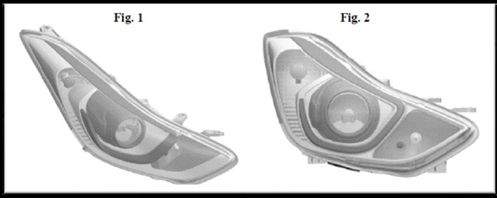Lighting the Way: ITC Decides First Case Under the Interim ID Program, Holds Domestic Industry Cannot Be Shown with Aggregated Investments in Multiple Products Covered by Different Patents
Apr 04 2024
An audio summary of this article is available in the player below. Scroll to keep reading.
Listen and subscribe to Womble Perspectives wherever you get your podcasts.
On March 22, the US International Trade Commission (ITC) issued the public version of its Commission Opinions (available here and here) in its very first case under the interim initial determination, or “Interim ID,” program. The Commission Opinions gives some insight into the fledgling program and a reminder of how to properly allocate investments to prove a domestic industry at the ITC.

Examples of Hyundai’s asserted design patents in the investigation.
The Interim ID program is the second program the ITC has introduced to provide more efficient and expeditious resolution of investigations. The 100-day program, introduced in 2013, gave the ITC’s Commissioners the authority to order the presiding Administrative Law Judge to issue a finding on case-dispositive issues.
The Interim ID program, instituted in 2021, allows an ALJ to hold an early evidentiary hearing on issues that are either case-dispositive or could significantly narrow the scope of the investigation. The Interim ID program differs from the 100-day program in giving the ALJ, rather than the Commissioners, the discretion to designate issues for an Interim ID and allows the Interim ID program to be used for issues that will not be case-dispositive.
Carmakers Kia and Hyundai filed complaints alleging violation of 19 U.S.C. § 1337 (section 337) by importation of infringing replacement automotive lamps that infringe the carmakers’ design patents. Hyundai is Kia’s largest shareholder, so the investigations were consolidated.
When a section 337 investigation is based on patent infringement, as it was in this case, the complainants bear the burden of satisfying the section 337 domestic industry (DI) requirement, i.e., there exists or is in the process of being established an industry in the United States relating to the articles protected by the patents. There are two prongs to the DI requirement: the technical prong, which is satisfied by showing the complainant’s products (DI products) practice the patent, and the economic prong which is satisfied by showing significant or substantial investment in the DI product by investments in subsection 337(a)(3)(A) plant and equipment, (B) labor and capital, or (C) engineering, research and development, or licensing.
Both investigations alleged that the technical prong was satisfied by various replacement lights that were each covered by a single patent with no overlap in patent protection among any of the DI products.
The presiding Chief ALJ entered the investigations into the Interim ID program regarding the economic prong of the domestic industry requirement. The ALJ issued a finding that the economic prong was satisfied by investments in subsections (A) and (B).
The Respondents petitioned for review of the ALJ’s finding that the economic prong had been satisfied. On review, the Commission vacated the ALJ’s findings on the economic prong.
The Commission Opinion found that the complainants and ALJ had improperly aggregated all investments to find that the total amount of investments were sufficient. The Commission held that the economic prong must be shown on a patent-by-patent basis. So where one domestic industry product practices only one patent, without overlapping protection of other patents, a complainant must show significant or substantial investments for each patent separately. This means that a complainant cannot pad its domestic industry numbers for one patent with investments in other articles protected by an entirely different patent.
The Opinion also found that complainants improperly aggregated investments across subsections (A) and (B) rather than showing patent-by-patent investments separately for each subsection. Because complainants improperly aggregated investments across multiple patents, improperly aggregated investments under subsections (A) and (B), and addressed importance of investments in general instead of as to each product, the ITC concluded that complainants failed to prove it had satisfied the economic prong of the domestic industry requirement with respect to any of the twenty-one patents. The ITC took no position on the technical prong.
What takeaways can be gleaned from this case? As frequently repeated in the decision itself, complainants should be careful to allocate investments properly and avoid aggregating. This is especially true for situations similar to the one discussed above, where there is no overlap among patents.
But proper allocation of investments is good practice in any investigation. The complainant bears the burden of proving satisfaction of the DI requirement. A complainant that alleges that multiple patents cover the DI product should be prepared to show the total investments per patent or risk a failure of proof. For example, if the claims of one patent are found non-infringed or invalid the aggregate investment amount will not provide accurate information on how much of the investment can be attributed to the remaining valid and infringed patent.
The ITC will continue to define the contours of the domestic industry requirement in section 337 and its Interim ID program. Womble attorneys have extensive experience at the ITC and include a former ITC attorney. We are uniquely positioned to guide clients through these complex developments. Do not hesitate to reach out to your usual Womble counsel or a specialist with any questions, comments, or concerns.